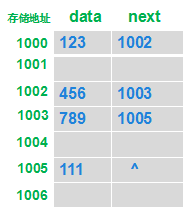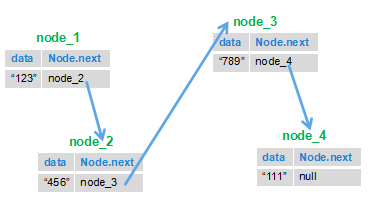一:单向链表基本介绍
链表是一种数据结构,和数组同级。比如,Java中我们使用的ArrayList,其实现原理是数组。而LinkedList的实现原理就是链表了。链表在进行循环遍历时效率不高,但是插入和删除时优势明显。下面对单向链表做一个介绍。
单向链表是一种线性表,实际上是由节点(Node)组成的,一个链表拥有不定数量的节点。其数据在内存中存储是不连续的,它存储的数据分散在内存中,每个结点只能也只有它能知道下一个结点的存储位置。由N各节点(Node)组成单向链表,每一个Node记录本Node的数据及下一个Node。向外暴露的只有一个头节点(Head),我们对链表的所有操作,都是直接或者间接地通过其头节点来进行的。

上图中最左边的节点即为头结点(Head),但是添加节点的顺序是从右向左的,添加的新节点会被作为新节点。最先添加的节点对下一节点的引用可以为空。引用是引用下一个节点而非下一个节点的对象。因为有着不断的引用,所以头节点就可以操作所有节点了。
下图描述了单向链表存储情况。存储是分散的,每一个节点只要记录下一节点,就把所有数据串了起来,形成了一个单向链表。

节点(Node)是由一个需要储存的对象及对下一个节点的引用组成的。也就是说,节点拥有两个成员:储存的对象、对下一个节点的引用。下面图是具体的说明:

二、单项链表的实现
/***@authorAdministrator*/
public classMyLink {
Node head= null; //头节点
/*** 链表中的节点,data代表节点的值,next是指向下一个节点的引用
*
*@authorzjn
**/
classNode {
Node next= null;//节点的引用,指向下一个节点
int data;//节点的对象,即内容
public Node(intdata) {this.data =data;
}
}/*** 向链表中插入数据
*
*@paramd*/
public void addNode(intd) {
Node newNode= new Node(d);//实例化一个节点
if (head == null) {
head=newNode;return;
}
Node tmp=head;while (tmp.next != null) {
tmp=tmp.next;
}
tmp.next=newNode;
}/***
*@paramindex:删除第index个节点
*@return
*/
public boolean deleteNode(intindex) {if (index < 1 || index >length()) {return false;
}if (index == 1) {
head=head.next;return true;
}int i = 1;
Node preNode=head;
Node curNode=preNode.next;while (curNode != null) {if (i ==index) {
preNode.next=curNode.next;return true;
}
preNode=curNode;
curNode=curNode.next;
i++;
}return false;
}/***
*@return返回节点长度*/
public intlength() {int length = 0;
Node tmp=head;while (tmp != null) {
length++;
tmp=tmp.next;
}returnlength;
}/*** 在不知道头指针的情况下删除指定节点
*
*@paramn
*@return
*/
public booleandeleteNode11(Node n) {if (n == null || n.next == null) {return false;
}int tmp =n.data;
n.data=n.next.data;
n.next.data=tmp;
n.next=n.next.next;
System.out.println("删除成功!");return true;
}public voidprintList() {
Node tmp=head;while (tmp != null) {
System.out.println(tmp.data);
tmp=tmp.next;
}
}public static voidmain(String[] args) {
MyLink list= newMyLink();
list.addNode(5);
list.addNode(3);
list.addNode(1);
list.addNode(2);
list.addNode(55);
list.addNode(36);
System.out.println("linkLength:" +list.length());
System.out.println("head.data:" +list.head.data);
list.printList();
list.deleteNode(4);
System.out.println("After deleteNode(4):");
list.printList();
}
}
三、链表相关的常用操作实现方法
1. 链表反转
/*** 链表反转
*
*@paramhead
*@return
*/
publicNode ReverseIteratively(Node head) {
Node pReversedHead=head;
Node pNode=head;
Node pPrev= null;while (pNode != null) {
Node pNext=pNode.next;if (pNext == null) {
pReversedHead=pNode;
}
pNode.next=pPrev;
pPrev=pNode;
pNode=pNext;
}this.head =pReversedHead;return this.head;
}
2. 查找单链表的中间节点
采用快慢指针的方式查找单链表的中间节点,快指针一次走两步,慢指针一次走一步,当快指针走完时,慢指针刚好到达中间节点。
/*** 查找单链表的中间节点
*
*@paramhead
*@return
*/
publicNode SearchMid(Node head) {
Node p= this.head, q = this.head;while (p != null && p.next != null && p.next.next != null) {
p=p.next.next;
q=q.next;
}
System.out.println("Mid:" +q.data);returnq;
}
3. 查找倒数第k个元素
采用两个指针P1,P2,P1先前移K步,然后P1、P2同时移动,当p1移动到尾部时,P2所指位置的元素即倒数第k个元素 。
/*** 查找倒数 第k个元素
*
*@paramhead
*@paramk
*@return
*/
public Node findElem(Node head, intk) {if (k < 1 || k > this.length()) {return null;
}
Node p1=head;
Node p2=head;for (int i = 0; i < k; i++)//前移k步
p1 =p1.next;while (p1 != null) {
p1=p1.next;
p2=p2.next;
}returnp2;
}
4. 对链表进行排序
/*** 排序
*
*@return
*/
publicNode orderList() {
Node nextNode= null;int tmp = 0;
Node curNode=head;while (curNode.next != null) {
nextNode=curNode.next;while (nextNode != null) {if (curNode.data >nextNode.data) {
tmp=curNode.data;
curNode.data=nextNode.data;
nextNode.data=tmp;
}
nextNode=nextNode.next;
}
curNode=curNode.next;
}returnhead;
}
5. 删除链表中的重复节点
/*** 删除重复节点*/
public voiddeleteDuplecate(Node head) {
Node p=head;while (p != null) {
Node q=p;while (q.next != null) {if (p.data ==q.next.data) {
q.next=q.next.next;
}elseq=q.next;
}
p=p.next;
}
}
6. 从尾到头输出单链表,采用递归方式实现
/*** 从尾到头输出单链表,采用递归方式实现
*
*@parampListHead*/
public voidprintListReversely(Node pListHead) {if (pListHead != null) {
printListReversely(pListHead.next);
System.out.println("printListReversely:" +pListHead.data);
}
}
7. 判断链表是否有环,有环情况下找出环的入口节点
/*** 判断链表是否有环,单向链表有环时,尾节点相同
*
*@paramhead
*@return
*/
public booleanIsLoop(Node head) {
Node fast= head, slow =head;if (fast == null) {return false;
}while (fast != null && fast.next != null) {
fast=fast.next.next;
slow=slow.next;if (fast ==slow) {
System.out.println("该链表有环");return true;
}
}return !(fast == null || fast.next == null);
}/*** 找出链表环的入口
*
*@paramhead
*@return
*/
publicNode FindLoopPort(Node head) {
Node fast= head, slow =head;while (fast != null && fast.next != null) {
slow=slow.next;
fast=fast.next.next;if (slow ==fast)break;
}if (fast == null || fast.next == null)return null;
slow=head;while (slow !=fast) {
slow=slow.next;
fast=fast.next;
}returnslow;
}
转载自:https://blog.csdn.net/jianyuerensheng/article/details/51200274


)

)



![[译]Java 垃圾回收介绍](http://pic.xiahunao.cn/[译]Java 垃圾回收介绍)



 没完成,先分享下...)



)


